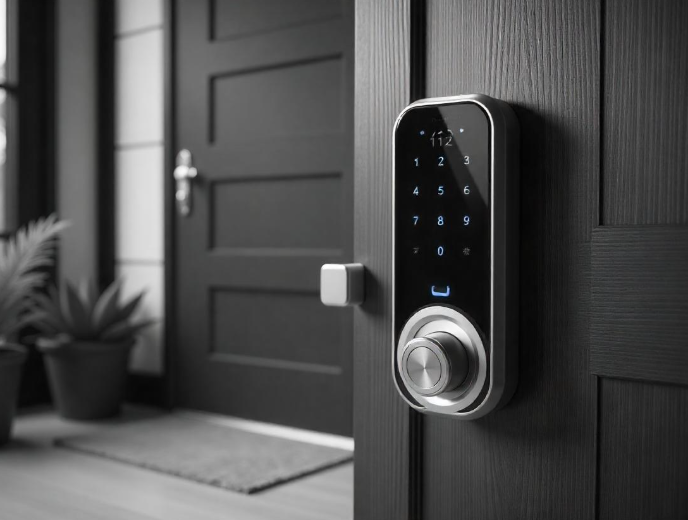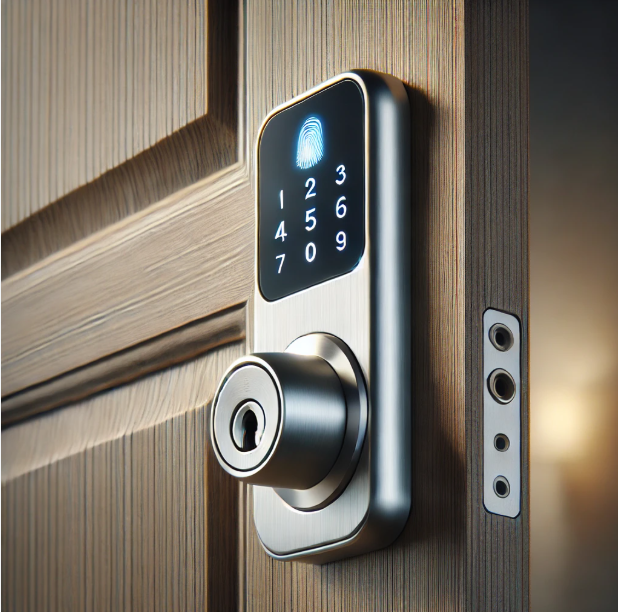The smart lock IoT integration landscape is transforming home security by connecting locks to the Internet of Things (IoT), enabling seamless control, monitoring, and automation. In 2025, these advanced systems leverage IoT to integrate with smart home ecosystems, offering remote access, real-time alerts, and compatibility with devices like lights, cameras, and voice assistants. A smart lock IoT integration combines convenience with robust smart lock safety, making it a cornerstone of modern smart homes. This article explores the latest advancements, setup tips, and practical advice for integrating smart locks into your IoT network. For expert guidance, visit this smart lock guide.
With the global smart lock market projected to reach $4.46 billion by 2025, driven by IoT advancements and urban security demands, smart lock IoT integration is no longer a luxury but a necessity. These systems use protocols like Wi-Fi, Thread, and Matter to create interconnected environments, allowing users to manage their locks from anywhere. Whether you’re a homeowner seeking automation or a renter needing flexible solutions, understanding smart lock IoT integration ensures you maximize security and convenience.
How Smart Lock IoT Integration Works
Smart lock IoT integration connects electromechanical locks to the internet via protocols like Wi-Fi, Bluetooth, Z-Wave, Zigbee, or 5G NB-IoT, enabling communication with smartphones, hubs, and other smart devices. These locks use sensors and software to process commands, monitor status, and exchange data with IoT ecosystems. For example, a lock can notify your phone if the door is left ajar or integrate with a smart thermostat to adjust settings upon entry.
Key components include a microcontroller (e.g., ESP32 or NodeMCU) for connectivity, a mobile app for remote control, and secure encryption to protect data. Advanced models incorporate AI to analyze access patterns, enhancing smart lock safety by detecting anomalies like unauthorized attempts. Integration with platforms like Amazon Alexa, Google Home, or Apple HomeKit allows voice commands, such as “Lock the door,” for hands-free operation.
Smart lock setup typically involves installing the lock, connecting it to Wi-Fi or a hub, and pairing it with an app. For how to pair smart lock with IoT systems, scan a QR code or follow app prompts to link to your ecosystem, taking about 5-10 minutes. This connectivity enables features like remote unlocking, guest access, and activity logs, making smart lock IoT integration a game-changer for modern security.
Benefits of Smart Lock IoT Integration
Smart lock IoT integration offers unmatched convenience by eliminating physical keys. You can unlock your door from anywhere using a smartphone app, ideal for granting access to guests or service providers remotely. Real-time notifications alert you to lock events, such as when a child arrives home or if tampering occurs, enhancing smart lock safety.
Integration with other IoT devices creates automated routines. For instance, entering your home can trigger lights to turn on or a security camera to deactivate, streamlining daily tasks. In rentals, smart lock IoT integration simplifies guest management by issuing temporary digital keys that auto-expire, perfect for Airbnb hosts.
Energy efficiency is another perk, with low-power protocols like Thread extending smart lock battery life to 12-18 months. Rechargeable batteries and low-battery alerts reduce maintenance hassles. By reducing key-related costs and enabling insurance discounts, smart lock IoT integration delivers long-term savings while elevating home automation.

Key Features of Smart Lock IoT Integration
When choosing a smart lock with IoT integration, prioritize features like Matter compatibility for seamless connection across Apple, Google, and Amazon ecosystems. Wi-Fi-enabled locks offer direct internet access, while Thread or Zigbee models use low-power mesh networks for extended smart lock battery life.
Look for multi-factor authentication, combining biometrics (e.g., fingerprints) with app-based controls for enhanced smart lock safety. Activity logs and tamper alerts provide real-time monitoring, while guest access features allow time-sensitive digital keys. Video-enabled locks, like the Eufy Video Smart Lock, integrate cameras for visual verification, adding a layer of security.
Voice assistant support enables commands like “Unlock the front door” via Alexa or Siri, while IFTTT compatibility connects locks to devices like Philips Hue lights. Durable designs with ANSI Grade 1 ratings ensure reliability, and weather-resistant builds suit outdoor use. User-friendly apps simplify connect smart lock processes, making integration intuitive.
Installation and Setup for Smart Lock IoT Integration
Smart lock installation for IoT-enabled models is designed for DIY ease, typically requiring a screwdriver and 20-30 minutes to replace a standard deadbolt. Ensure compatibility with door dimensions (1-3/8 to 2 inches thick). Retrofit options, like the August Wi-Fi Smart Lock, attach to existing hardware, making them renter-friendly.
For smart lock setup, power the lock with batteries, connect to Wi-Fi or a hub, and pair via the app. To connect smart lock to IoT systems, select your platform (e.g., HomeKit) and follow prompts, often involving a QR code scan. Test integrations with other devices, like smart lights, to confirm automation. Professional installation is available for complex setups, ensuring proper alignment and connectivity.
Portable smart lock options, which attach without drilling, are ideal for temporary or rental setups. Post-installation, verify signal strength to avoid connectivity issues, a key smart lock tip for robust IoT performance.
Enhancing Security with Smart Lock IoT Integration
Smart lock IoT integration bolsters security through real-time monitoring and alerts. If an unauthorized access attempt occurs, the system notifies you instantly, often integrating with cameras for evidence. AI-powered locks analyze usage patterns to flag anomalies, like unusual entry times, enhancing smart lock safety.
For rentals or offices, digital keys simplify access management, auto-revoking after set periods. Integration with access control systems provides comprehensive building oversight, tracking usage across doors and amenities. This creates a unified security experience, from front gates to unit doors.
Smart lock tips include using strong, unique passwords and enabling two-factor authentication to prevent hacking. Regular smart lock maintenance, like firmware updates, patches vulnerabilities, ensuring your IoT network remains secure. Pairing with sensors or alarms creates a cohesive defense system, ideal for urban homes.
Common Issues and Troubleshooting for Smart Lock IoT Integration
Connectivity issues, like Wi-Fi drops, are common with smart lock IoT integration. For smart lock troubleshooting, reset the network by holding the lock’s reset button and re-pairing via the app. Weak signals may require a Wi-Fi extender or hub placement closer to the lock.
Battery drain can occur with frequent IoT interactions; monitor smart lock battery life through app alerts and replace or recharge as needed. USB-C ports simplify recharging. If integrations fail, check hub compatibility or update firmware. Backup keys ensure access during outages, a critical smart lock safety feature.
Apps often include diagnostics to identify issues like sensor errors. The best smart lock guide suggests checking user forums for community fixes but prioritizing official updates for security. Most issues resolve quickly, maintaining the reliability of your smart lock with IoT integration.

Comparing Smart Locks with IoT Integration
When selecting a smart lock with IoT integration, evaluate connectivity options (Wi-Fi, Thread, or 5G NB-IoT) and ecosystem compatibility. Wi-Fi models like the Schlage Encode offer direct access, while Thread-enabled locks save power. Video locks add monitoring, ideal for high-security needs.
Prices range from $100 for basic models to $400 for advanced setups with biometrics and video. Retrofit portable smart lock options suit renters, while full deadbolts fit homeowners. Prioritize smart lock battery life (up to 18 months) and encryption for smart lock safety. The best smart lock guide recommends testing apps for ease and ensuring multi-user support.
Future Trends in Smart Lock IoT Integration
The smart lock IoT integration landscape is evolving with AI-driven features, like predictive alerts based on usage patterns, and blockchain for secure digital keys. 5G NB-IoT, as seen in Digital Keys locks, offers low-power, long-range connectivity, ideal for remote areas.
Augmented reality (AR) will simplify smart lock installation with virtual guides, while Matter ensures universal compatibility. Sustainable designs with solar-powered batteries will extend smart lock battery life indefinitely. These advancements will make smart lock IoT integration a cornerstone of smart cities and homes.
Conclusion: Embrace Smart Lock IoT Integration for a Smarter, Safer Home
Smart lock IoT integration is revolutionizing home security by connecting locks to a network of smart devices, offering unmatched control and automation. From remote access to AI-enhanced monitoring, these systems deliver convenience and smart lock safety. By following smart lock tips for setup, maintenance, and troubleshooting, you can optimize performance. Explore trusted home security tips to find the ideal smart lock with IoT integration for your needs. Upgrade today for a secure, connected future.